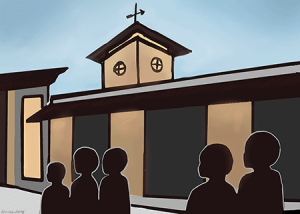How the SAT is Fueling the Wealth Gap

December 2, 2020
All high schoolers are unique, but we all share one common hatred: the College Board, the company that profits off our pain by creating pricey tests that are often requirements for college admission — the AP Exams, SAT Subject Tests, and of course, the dreaded SAT. The standardized test, which has consistently shown to be a poor measure of a student’s intelligence, is a necessity for someone who wants a place on the competitive, capitalist job market. The SAT, however, is actually a better measure of one’s privilege and advantage in society as opposed to their raw intelligence. The test itself is ruining the futures of less fortunate Americans. The wealthiest students receive the most support in the form of tutoring and prep courses and therefore do the best on the SAT. From there, they are more competitive in the college and job market, increasing their wealth as compared to those who did less well on the test.. It’s time we got rid of this bigoted test.
Many young high school students have taken civic action by protesting and fighting for equality amongst classes, races, genders, etc. However, by complying with the status quo and taking the SAT, high schoolers like me are inadvertently fueling the fire of the wealth gap, which is increasing by a staggering margin each year.
 According to Pew Research Center, the wealthiest 1% of citizens own 29% of the nation’s total wealth. For comparison, the bottom 80 percent, or “blue-collar” workers, only own 7%. The top 10% also own 70% of the wealth. Only the top 20 percent of Americans have made a significant financial recovery since the Great Recession in 2008, and they contribute to almost all of the United States’s GDP growth since then. The median income between black and white households also differs by almost $33,000 a year. These dire statistics can be largely attributed to a variety of causes and the SAT is undoubtedly one of them.
According to Pew Research Center, the wealthiest 1% of citizens own 29% of the nation’s total wealth. For comparison, the bottom 80 percent, or “blue-collar” workers, only own 7%. The top 10% also own 70% of the wealth. Only the top 20 percent of Americans have made a significant financial recovery since the Great Recession in 2008, and they contribute to almost all of the United States’s GDP growth since then. The median income between black and white households also differs by almost $33,000 a year. These dire statistics can be largely attributed to a variety of causes and the SAT is undoubtedly one of them.
We know that wealthy students get into better colleges and remain at their initial income levels or higher, while poor students, including many minorities, are beaten down by the system which ensures that they keep their position at the bottom of the economic and social hierarchy. The SAT is inadvertently painting students who receive poor scores as unintelligent and, in a capitalist society, the unintelligent fall to the bottom of the ladder. Bigotry and inequality in general are the main culprits of this problem, but the SAT is a significant side character. In 2019, actress Lori Laughlin and 50 others were caught in a scandal paying institutions such as USC large sums of money for their children to attend prestigious schools. The SAT, which is meant to be an objective measure of a student’s intelligence, but, similarly to the elite schools receiving bribes, also picks and chooses “winners” based on their socioeconomic status and often even their race. According to the Brookings Institute, students whose household income is greater than $200,000 outscore students whose household income is less than $20,000 by almost 300 points on a 1600-scale. Asian Students are also outscoring Black and Hispanic students by about 300 points.
To the naked eye, it might seem as if the wealthier were “harder workers” and that’s why they get better scores and end up having higher incomes. A difference in drive, work ethic, and talent can not entirely explain a difference in wealth and prosperity. Similarly, an SAT score cannot be attributed entirely to one’s work ethic or intelligence. According to an MIT reviewed model, more prosperous people didn’t actually work harder. They had better circumstances and better resources. Poorer people and people of color do not get the same opportunity as their peers to do well on the SAT and to “succeed” in life. But to most people, it might seem as if the harder worker always gets the best score and the most success.
From a superior SAT score, wealthier students can go on to better colleges to make more money and send their children to better schools while the rest stay stuck on square one; it’s a vicious cycle. Let’s not play favorites either. Albuquerque Academy is not helping the cause. The rest of the city consistently paints us as smart, but “elitist.” In reality, the narrative should be smart because we’re elitist. According to Niche, Albuquerque Academy is the #1 ranked private high school in the city and also has the highest average SAT score. Unfortunately, tuition is a staggering $24,795. Only ¼ of those students are receiving any financial aid. Academy’s consistently high average SAT score can be attributed to good quality education but can also be attributed to high-profile student backgrounds. I personally come from an academic and medical background. On the other hand, the average student at Highland high school has a median income of $34,521, which is well below the national average, and the idea of attending Albuquerque Academy might never be a possibility for that average student even with financial aid. Wealthier individuals are going to get better tutoring, better education, and better support, therefore ensuring that they receive a better score on the SAT. The Princeton Review’s SAT prep course costs a staggering $1600 — no wonder students’ average SAT scores at Highland High School trail by more than 200 points. I get to go home to a loving family and stable income each and every night while plenty of Highland students can’t say for sure they have a meal tonight. We cannot expect vastly distinct groups of people to reach the same heights when we aren’t offering equity and equal opportunity to both groups.
The last counterargument one might make is that a low SAT score does not mean lower success rate. According to Business Insider, the students with higher SAT scores ended up getting more PhDs, filing more patents, and getting more tenure positions at top-50 universities. All of those things inevitably lead to a higher salary. After proving that the SAT is a better measure of your bank account and your privilege as opposed to your intelligence, should we really be allowing so much of one’s success to come down to a single test?
The SAT is meant to be an objective and impartial measure of what a student learned in high school, but it is not. It is instead a capitalist means of ensuring that the poor get poorer and the rich get richer. The most avid capitalists will continue to perpetuate the myth that if you work hard enough, you can do whatever you want. The SAT is not a measure of one’s worth, but instead a measure of one’s privilege and circumstance. It’s time we recognize that we at the Albuquerque Academy are no better than any other students in the state, but rather, we are extremely blessed. So next time you’re quick to hand out judgment to your peers who didn’t perform as well on the SAT, understand that there’s more to a poor SAT score than meets the eye.








Dean Jacoby • Dec 2, 2020 at 2:13 pm
I appreciate the author bringing up his concerns with the SAT (which I imagine he also attributes to the ACT). Speaking for just myself (but feeling confident that my fellow college counselors have similar opinions), I have always seen standardized testing as currently constructed to be a very imperfect measure of college success. The College Board can only prove that it more-or-less accurately predicts first year college GPA. I think that there has to be a better way to evaluate a student’s ability to do college work.
The University of California system must agree since they recently decided to not use the SAT or ACT and is in the process of trying to create a better test.
Another important point when talking about testing is that, because of the pandemic, 1,600 colleges and universities became temporarily test optional. This is an important opportunity to measure whether testing is useful or not in the admissions process using large scale hard data. It is quite possible that colleges see the advantages of de-emphasizing standardized testing and that use of the tests becomes less important post-COVID.
Dean Jacoby
College Counselor